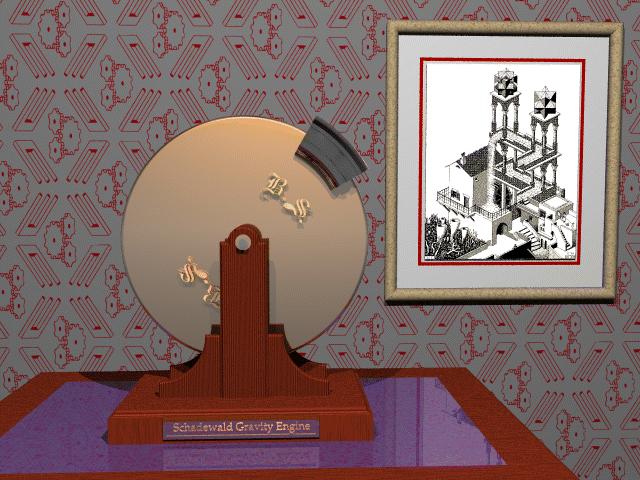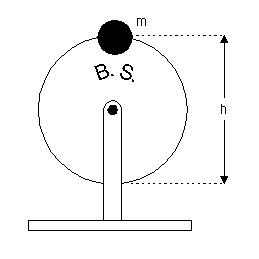Discussion of the Bob Schadewald Gravity Engine.
 |
| Bob Schadewald's Gravity engine. Art © by Bob Schadewald. |
|---|
 Bob's deception is so absurdly simple that everyone who has offered
public commentary on this has, so far as I know, missed it. The wheel does
gain kinetic energy on the downward half cycle; we can't deny that.
Bob then says that
the eccentric mass then has more than enough kinetic energy for it
to rise to the top again against the force due to gravity (which will
be slightly smaller while the mass rises).
That's also true. But does the wheel therefore
gain kinetic energy over the "long haul" of successive cycles, providing
excess energy we can tap?
Bob has cleverly led us to suppose it will. But if his logic and assumptions
are followed to their conclusion, we see that it will not.
Bob's deception is so absurdly simple that everyone who has offered
public commentary on this has, so far as I know, missed it. The wheel does
gain kinetic energy on the downward half cycle; we can't deny that.
Bob then says that
the eccentric mass then has more than enough kinetic energy for it
to rise to the top again against the force due to gravity (which will
be slightly smaller while the mass rises).
That's also true. But does the wheel therefore
gain kinetic energy over the "long haul" of successive cycles, providing
excess energy we can tap?
Bob has cleverly led us to suppose it will. But if his logic and assumptions
are followed to their conclusion, we see that it will not.
Simple answer.
The only energy we could possibly extract from this system would be that kinetic energy the ball attains during its first fall to the floor, slightly less than mgh.
Elaboration.
Decreasing the gravaitational field decreases the potential energy of the weight at any point in its motion. Compared to the constant field case, the wheel's kinetic energy increases during every time interval by an amount equal to its potential energy loss due to the decreased strength of the field during that interval. So the wheel's total energy is continually conserved.
Therefore, if the gravitational field were decreasing (or increasing) the wheel's total energy would still be conserved, and there would be no excess energy.
Why did Bob say "My description is a subtle deception. The velocity of the moving weight will never exceed what it was when it passed the bottom, dead center, the first time, even if there is no friction. The weight may pick up speed at the top, but never at the bottom, so there is never any real speedup in the wheel."
Bob chose his words carefully. Let's use the bottom of the wheel for the zero of potential energy. So, conserving total energy, the kinetic energy at the bottom must increase after every cycle. Bob's teasing comment was correct. The kinetic energy at the top must increase after each cycle. Energy is conserved during each cycle.
Eventually, when the gravitational field finally decreases to zero, the speed of the wheel reaches a steady value. What value? Why, simply a value equal to the potential energy it had when it started, when the weight was at its highest point. At every point (except the lowest point) its kinetic energy is larger there than it was when it was there in the previous cycle. Freshman physics. No advanced concepts needed. No mathematical calculation needed.
But, since we are taking the base of potential energy at the bottom, where it is zero, the wheel's velocity there is constant, always equal to its initial potential energy at the top. So Bob is again correct when he says, "It does not increase at the bottom." Bob is diabolically clever.
The sleight of mind that Bob employed was to avoid any explicit mention of potential energy. Readers focused only on speed and kinetic energy. Remember, speed is not conserved. Energy is.
Can we test this? We have no way to alter gravitational fields except to move the field source steadily away from our SGE (Shadewald Gravity Engine). Or vice versa. Imagine the whole SGE at a great height, falling toward the earth. It experiences a decreasing strength of field. It doesn't need to be the SGE, a simple pendulum falling would suffice. Will the pendulum's period change as it falls? It surely will. But no laws of physics are violated in the process.
This can be tested in the laboratory, where we can easily increase or decrease the size of a electric field acting on our apparatus. It can also be done with magnetic fields.
So, even if you had a continuously falling laboratory, no perpetual motion device would work in it.
More detailed analysis.
We will begin with an energy analysis, just to see what's going on. Suppose that we do include some mechanism for extracting that extra amount of energy at the end of each cycle. This returns the wheel to zero speed at the top, so it begins from rest each cycle. But during each cycle the kinetic energy gain at the top is mh(gf - gi) = mhQ where Q = gf - gi is the small change in g during one cycle. Q is a negative quantity, and is just equal to the change in the potential energy at the top of the cycle due to the decrease of g.
By the time n cycles are completed we have extracted nQ = mgh of energy, the same amount we gave it initially by lifting the weight to the top to get the wheel started. During this time the speed at the bottom gradually decreases on subsequent cycles till it is zero when gravity "runs out". We can get no more energy from this machine than we put in initially.
There's a related puzzle in which we don't "steal energy" from the machine. We also assume there are no dissipative forces (like friction) removing energy from the machine. Then when gravity reaches zero the final kinetic energy of the wheel must be exactly what it was at the end of the first half-cycle. Also, it must then be moving at constant speed at all positions. That will be the same speed it had at the end of the first half-cycle.
Why did Bob say "the wheel may pick up speed at the top"? That will happen if we don't extract any energy from the machine, or don't extract it at a sufficient rate to ensure that the speed is zero at the top at the end of each cycle.
Also, if g happens to reach zero when the eccentric mass is anywhere but at the bottom, the mass will retain whatever speed it had at that point, and that includes the point at the top. This could be considerable if g decreases so rapidly it reaches zero during the first few cycles. But the speed at the top will never exceed the speed the mass had when it first reached bottom.
We have used only conservation of energy (kinetic and potential) in this discussion. The same result should be obtainable by a strictly kinematic analysis using Newton's laws.
Related Puzzles:
- How would steadily reducing gravity affect a simple pendulum? Amplitude? Period? Velocity at bottom of swing? Height of swing?
- How would steadily reducing gravity affect the motion of a mass suspended
from a Hookian spring (obeying Hooke's law), and bouncing up and down?
- —Donald E. Simanek, Jan 2002.
Return to The Museum of Unworkable Devices.